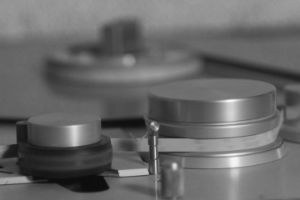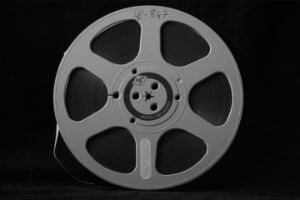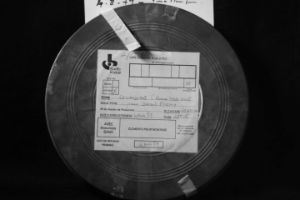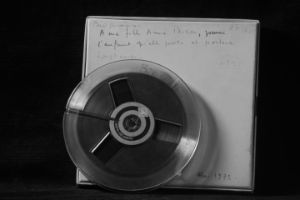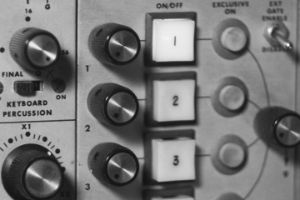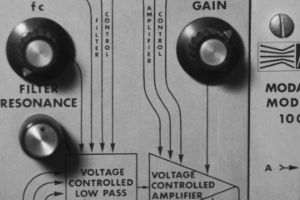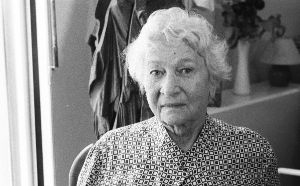
Éliane Radigue
© Éleonore Huisse
The Universe of Éliane Radigue
Stages of a music pioneer – A tribute on the occasion of her 90th birthday
Her pieces are subtle and calm, and draw on a profound compositional complexity – anyone listening to Éliane Radigue’s work will soon appreciate that her eminence as one of the foremost pioneers of electronic music is certainly deserved. In the 50 years that she has been writing music, she has created a rich and ambitious repertoire that is both consistent and constantly reinvents itself. Her oeuvre, influenced by a variety of musical trends and her own intransigence, consists of three phases that mark the development of her career and life during which she used first magnetic tape and feedback technologies, then analogue modular synthesizers and finally – most recently – acoustic instruments to explore the interior life of sounds and how these develop through the hearing process.
To mark her 90th birthday on 24 January, MaerzMusik – Festival for Time Issues will devote a special programme to Éliane Radigue, highlighting the many facets of the composer’s work.
1
DISCOVERINGÉLIANERADIGUE
Paris and Inspiring Encounters
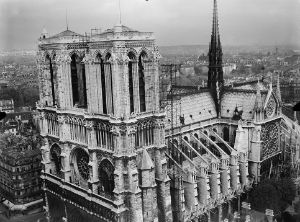
The Cathédrale Notre-Dame under construction in 1955
Musical Investigations 1
„The first musical stone that Éliane Radigue will set down, […], is that of opening to sounds and the role she leaves for listening, or even for several ‘listenings’. When she becomes the assistant of Pierre Henry, she immerses herself into the listening of a multitude of sounds. Her ear sharpens as she becomes familiar with sounds held in captivity, like time prisoners captured in a few inches of magnetic tape. […] The memorized sound, its color, its ‘behavior’ – that is to say, its specific potential as inscribed on a support – is open to the attention of the composer. What is forged, too, and stems directly from this concrete approach, is that the listening experience becomes part of the composition. The composition, indeed, for Éliane Radigue, is fully destined to its own actualization. What does that mean? This means that her music is a becoming. It is not a plan, not a program, not an idea. It is not disembodied. It needs to be tested to exist.”
(François Bonnet)
Éliane Radigue was born in Paris in 1932 where she grew up during the war and the German occupation. Her passion for classical music was awakened at an early age by her piano teacher, Madame Roger. She then moved to Nice, where she studied music theory and the harp at the Conservatoire and married the visual artist Arman, with whom she had three children. During her studies, she became aware of aesthetic ideas from a range of new developments then emerging in post-war European contemporary music, such as serialism. However, Radigue wasn’t interested to generate much enthusiasm or inspiration from the rational and unemotional aesthetic of these contemporary composers. She was far more interested in the musicality of sounds and noises surrounding her – such as the different types of airplanes that flew over Nice, which she could distinguished by encountering their sonorities. She was fascinated when she heared “Étude aux chemins de fer” for the first time on the radio in 1952 – composed by Pierre Schaeffer, the founder of ‚musique concrète‘, which incorporated such everyday noises and concrete sounds.
Pioneer of electronic music
Éliane Radigue is one of the few established female composers in the male-dominated genre of electronic music. In each phase, Éliane Radigue has reinvented her music, which resists ascription to any single 20th century genre. Facing a patriarchal system, her work has predominantly been excluded from large sections of the electronic music canon.
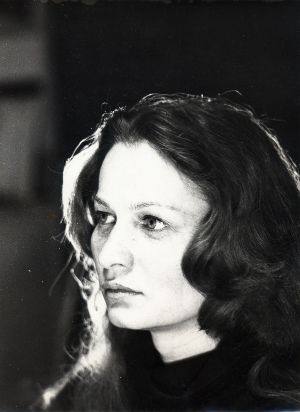
Éliane Radigue
Following a chance meeting with Pierre Schaeffer in Paris, in 1955 she started an internship at the Studio d’Essai that he had founded for Radiodiffusion-Télévision Française (RTF), where he conducted his sonic and theoretical experiments. During her residency, Radigue was able to learn how to use electronic instruments, recording equipment and microphones and acquired the indepth skillset of editing and mixing by means of usage of magnetic audiotape on which early electronic music was created.
Later on, she met contemporaries such as Iannis Xenakis, Luc Ferrari and Pierre Boulez and acquired a deeper knowledge of the sonic experiments, newly developed instruments and ongoing rivalry between musique concrète based in Paris and electronic music based in Cologne. During this time, Radigue travelled to Cologne to visit the Studio for Electronic Music, and attended the Darmstadt Summer Courses for New Music, one of the most important of the new music scene and places to exchange ideas. In the early 1960s, Éliane Radigue made her first extended visit to New York with her family, where she explored American art, which has become a new inspiration in her career. There she crossed paths with the likes of James Tenney and John Cage.
2
DISCOVERINGÉLIANERADIGUE
Early Electronic Pieces
Musical Investigations 2
“Another dimension of the ‚Radiguian‘ investigation can be observed in the different methodologies of work that she uses to compose. She began her composition practice with a very cerebral approach. Influenced by musical modernity and the avant-garde, she established sound series and developed scores that were exercises in thought at the limit of mathematics and combinatorics, sometimes even inspired by chess games. She then developed her first works using the techniques of Larsen effects and feedback, which she differentiates as follows: Larsen effects describe the acoustic phenomena appearing when a sound interaction loop is created between a microphone and a speaker, while feedback is more a re-injection of the signal using a tape recorder that reads and reproduces the sound it has generated itself.” (François Bonnet)
Éliane Radigue created her compositions after a ten-year career break that she devoted to bringing up her children. After her divorce from Arman in 1967, she began working in Paris as Pierre Henry’s assistant at the Apsome Studio. In solitude, she developed her unique take on composition while working late at night in the studio – but her efforts encountered rejection from Schaeffer and Henry.
In her first pieces, Radigue experimented with protracted loops, electronic feedback – where sound is repeated between a microphone, loudspeaker and tape – using tape manipulation to slow sounds down: by doing this she created slowly unfolding, delicate sound transformations in which she enabled listeners to hear the inner life of the sounds and their complex spectrum of tonality and sub-harmonies. Her pieces became a gentle, meditative experience marked by their expansive, unhurried nature, challenging listeners’ ability to hear barely noticeable changes in her works. Between 1967 and 1970 she composed the works “Jouet Electronique” (1967) and “Elemental I” (1968) at the Apsome Studio. After that, she finished working for Henry and – notably as one of the few female composers at that time – she set up her own small studio at home with tape machines, a mixer, loudspeakers and microphones, where she continued to explore and expand her compositional techniques. This was the space in which she created pieces such as “Usral” (1969), “In memoriam ostinato” (1969), “Stress Osaka” (1969), “Opus 17” (1970), “Omnht” (1970) and “Vice-Versa” (1970).
„[A]fter producing her sound material, Éliane Radigue lets the sounds ‘rest’ for at least three months. Why? In order to forget them, to rediscover them with a new ear, detached from their production. It is very much a kind of ‘Musique Concrète distance’, so as only to apprehend the sound for itself. Then, each of her works, before being completed, is sifted through different types of listening: a distracted listening, first, intended to capture the general atmosphere; then a formal listening, focused on the development and deployment of music; and, finally, a critical listening, which coldly analyzes the technical realization of the work (modulation, timbre, fades).“
François Bonnet
3
DISCOVERINGÉLIANERADIGUE
New York and Discovering the ARP 2500
In 1970 Éliane Radigue returned to the USA for a residency at the New York University School of Arts and for the first time composed a work using modular synthesizers, a key moment in her career that would launch a new phase of her work as a composer. She composed the first piece “Chry-ptus” (1970), using a Buchla synthesizer that Morton Subotnick had set up in a studio at New York University, and which she shared with Laurie Spiegel and Rhys Chatham. However, shortly after this, Radigue fell in love with the ARP 2500 Synthesizer and was so drawn by its tone colour that it would go on to feature in most of her electronic pieces for the next 30 years.
In New York in the 1970s, she met James Tenney, Steve Reich and David Tudor, while exploring avant-garde music in the USA. For the first time she heard about minimalist music, happenings, Fluxus, performances and encounters other interdisciplinary art forms. It seems that Radigue resonated with such environments, musical ideas and concepts of working with sound, more than she had previously been enountered in France. Upon her return to Paris from New York, she brought her own ARP 2500 with her, which she lovingly named Jules, and she used it to compose many of her works: the “Adnos” trilogy, “Geelriandre” (1972), “Ψ 847” (1973), “Biogénésis” (1973), “Transamorem-Transmortem” (1974), “Les Chants de Milarepa” (1983), “Jetsun Mila” (1986) and the “Trilogie de la Mort” (1988-1993).
Works from the Years 1970 - 2000
Programme of MaerzMusik 2022
Musical Investigations 3
“Each work of Éliane Radigue finds its point of departure in her life: it can be an impression, an ordeal, a story. These reasons, often personal, are not revealed. They are used as backdrops, covered by sounds and faded into music. Each of these stories, these states, have their own time and their own temporality. And their inner duration, resonates and reverberates in musical time. Also, there is in Éliane Radigue’s work this fascination for becoming. This can be close to what Marcel Duchamp, whom Éliane knew, called ‘the infra-thin’. ‘The warmth of a seat (which has just been left)', says Duchamp, ‘is infra-thin’.’ […] The infra-thin is an absent presence – a residue of presence that marks and actualizes the difference, as miniscule as it may be, between what has been and what persists – at the point where the trace draws out presence to the point of disappearance. The infra-thin is also this interworld where things evolve imperceptibly. To make sounds evolve, incessantly, in a sensitive but imperceptible way, that is what could be the secret reason of Éliane Radigue’s music.“ (François Bonnet)
In 1975 she converted to Tibetan Buddhism and at about the same time she was diagnosed with partial deafness. Radigue then retired for several years. She resumed her career again in 1979 and carried on working with the ARP 2500, allowing Buddhist philosophy and spirituality to flow into her music, which continued to deal with themes such as death and rebirth.
“L’île re-sonante” (2000) would become her final electronic piece with the ARP 2500, before the instrument had to move out of her studio indefinitely and she devoted herself to acoustic instruments and collaborations with musicians – a practice she continues to this day.
4
DISCOVERINGÉLIANERADIGUE
The Purely Acoustic Phase: Turning Away from Electronics
Since 2001, Radigue has composed exclusively for acoustic instruments. She combines the precise observation and procedural generation of sounds with the exploration of collective creation processes. Her pieces for instrumentalists are not notated – they are communicated orally and are co-composed with the musicians through conversation and through an extensive search for just the right sound for each work.
After decades of working on her synthesizer alone in the studio, where she was able to make all the musical decisions herself, she has now become involved in collective processes and exploring the relationship that connects musicians and their instruments. In a comprehensive interview with Julia Eckhardt (“Intermediary Spaces”, published in 2019) Éliane Radigue talks about the margin of imprecision which occurs in oral transmission as well as in the musical score. She declares that in both cases there is the necessity of mental projection: “Naturally, there is always a margin of imprecision and I am interested precisely in what happens within this margin, this little space that remains open to interpretation.”
“Oral transmission is the most widespread method in all the world’s music and actually not only for music, but also for speech – the vehicle of thought.”
Éliane Radigue
Since 2011, Éliane Radigue has continued her Occam series, a constantly growing cycle that she develops through intensive encounters with musicians from all around the world. So far she composed more than 25 Occam pieces, with a variety of either solo, duo or small ensemble line-ups which she – depending on the combination of musicians involved – describes as “OCCAM Rivers”, “OCCAM Deltas”, “Occam Heptas” and, in the case of the orchestral version, “OCCAM Océan”.
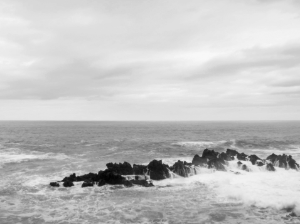
„Éliane Radigue – Échos“. A movie by Éleonore Huisse and François Bonnet, F 2021, Film Still
© Éleonore Huisse, François Bonnet
Musical Investigations 4
“For Éliane Radigue, it is always this same search for sounds that initiates the work with musicians. To look for modes of playing, to turn sounds around, to tame wolf tones, to discover the potentialities of the instruments and the sound potential of the instrumentalists. Sound exploration, here, is still very close to the spirit of Musique Concrète, but it is no longer a matter of collecting materials that will be laid on tapes and organized. On the contrary, it is a question of finding variables on which to act – in the same way that she was acting on certain parameters of her synthesizer – and thus of defining roads to take, to find strategies to make the sounds evolve. It is also about pushing the modes of playing to the extreme: to push the instrument and the musicians into their limits, forcing them to move into the music itself, to repeat the movements in the same way, but always different, with an infra-thin variation.” (François Bonnet)
Initial sound ideas are developed in personal conversations and through playful experiment until she arrives at a piece tailored for the respective musician(s). While the process dispenses entirely with a score, the exchange is always based on an image connected to the sea, which acts as a source of inspiration and communicator of ideas for the flowing, unbroken musical forms that merge into each other like waves, constantly allowing new forms to develop.
“Meeting Éliane at home there are always little rituals: we drink tea and talk. Then I will play her something I’ve done or I’ll play her various different sounds. Éliane will listen, make some comments and investigate what is physically possible with the instruments until we find the right sound, complete with overtones and the right harmonic spectrum and all the acoustic phenomena that fit the piece.”
The cellist Deborah Walker describes their process for her solo “Occam VIII”
Musical Investigations 5
“Éliane‘s music does not impose itself through loudness and flashy effects. Although it is a powerful music, it is a calm and confident power that does not need to crush the listener. Here again, the investigative spirit prevails, because it invites the listener to become immersed into the sound and go in search of music. This is how Éliane Radigue‘s music condenses time, not by a supposed slowness, but by the ‘work’ needed from the listener – that is to say, by a listening that is active and involved. In this sense, the music of Éliane Radigue is always a dialogue, a subtle complex, a plating, leaf by leaf, of listening and attention, concentration and drifting along, which navigates and moves from an idea to an image, from sound to form, from gesture to sensibility, from music to listening.” (Fançois Bonnet)
As well as during the process of composition, the musicians are also required to show considerable virtuosity when playing. Particularly when several instruments are playing together, the musicians need to listen to each other very intently and react to tiny changes without interrupting the flow of sounds. The extreme simplicity of the constantly expanding, quiet notes and the emphasis of the minimal movements of their microtonal inner life reveal their underlying complexity.
Radigue makes use of intensive listening she cultivated in her electronic music, taking advantage of the way sound slowly unfolds in space, and applies it to her collaborative work with musicians. The evolution of the pieces is always in flux: there is no final point at which the piece is complete: instead, Éliane Radigue decides when the process of development is finished and the piece can be performed. After that, she hands it over to her musicians who will continue to work on it. Her first orchestral piece, “Occam Océan”, was devised for and with the Paris ensemble ONCEIM – Orchestre de Nouvelles Créations, Expérimentations et Improvisations Musicales. It took two years to develop before it was performed for the first time in Paris in 2015. (text by Katja Heldt)
The Orchestral Piece Occam Océan
Programme of MaerzMusik 2022
Occam Océan
Frédéric Blondy, ONCEIM’s artistic director, explains: “The title OCCAM Océan alludes to the tides, to the forms that develop when full tide arrives: the water is still in the distance and one can only sense that it is coming, see the surf moving on the beach: slowly the water appears and it keeps coming closer until suddenly the sea is right here. The piece finally ends once the water has gone and all that’s left is the foam of the ocean rushing back across the beach.”
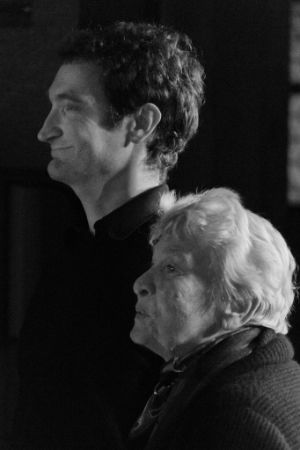
Frédéric Blondy and Éliane Radigue
© Jean-Christian Rieu
5
ÉLIANERADIGUEENTDECKEN
Outro - Éliane Radigue in Conversation
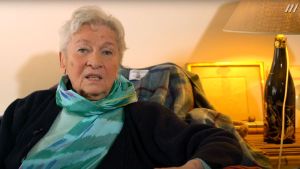
Éliane Radigue | Interview with Ludger Brümmer
© ZKM | Videostudio
